Gallery
- Brolga (1912)
- King Quail (1914)
- Kookaburra (1914)
- Magpie (1914)
- Pacific Black Duck shot in flight (1914)
- Southern Emu-wrens (1914)
- Spotted Pardalotes (1921)
- Superb Fairy-wrens (1914)
- White-winged Fairy-wrens (1914)
Herbert Hepburn Calvert (1870-1923) was an Australian watercolour artist. He commonly signed his paintings "H. H. Calvert".
Herbert Hepburn Calvert was born on 30 December 1870 in London. He was the first son of journalist Thomas Calvert and his wife Grace (née Hepburn).
In 1887 the family emigrated to Sydney, Australia where in 1904 H. H. Calvert married Mary Elsie O’Brien.
Calvert was known for his watercolours depicting Australian bird life. He was active from at least 1910 until his death in 1923 and is represented in the collections of the Mitchell Library, State Library of New South Wales and the Art Gallery of New South Wales. [1]
The work of Calvert's younger son, Harold Hepburn Calvert (1906–1963), is often incorrectly attributed to his father. This misidentification is exacerbated by both men having similar names and painting careers which overlapped in the early 1920s. In terms of subject matter, style and medium, Harold's art mirrored that of Herbert, however, the son usually signed his paintings as H. Hep. Calvert or H. Hepburn Calvert which helps differentiate his output.
Calvert died in Adelaide on 16 February 1923 [2] and was subsequently buried at the Field of Mars Cemetery in the Sydney suburb of Ryde. He was survived by his wife and sons Herbert and Harold.

George Washington Thomas Lambert was an Australian artist, known principally for portrait painting and as a war artist during the First World War.
Alfred William Rich was an English artist, teacher and author.
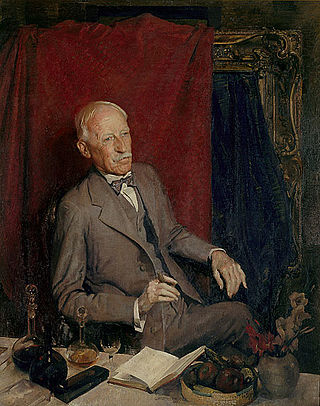
Julian Rossi Ashton was an English-born Australian artist and teacher. He is best known for founding the Julian Ashton Art School in Sydney and encouraging Australian painters to capture local life and scenery en plein air, greatly influencing the impressionist Heidelberg School movement.
John William Lewin was an English-born artist active in Australia from 1800. The first professional artist of the colony of New South Wales, he illustrated the earliest volumes of Australian natural history. Many of his illustrations were of native Australian birds on native Australian plants.
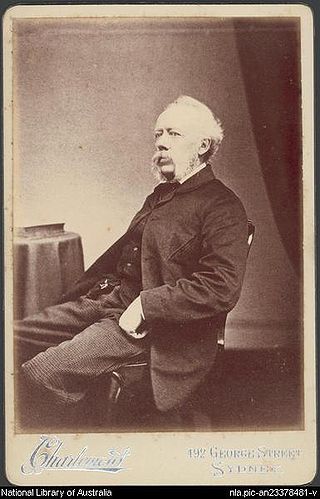
Conrad Martens was an English-born landscape painter active on HMS Beagle from 1833 to 1834. He arrived in Australia in 1835 and painted there until his death in 1878.

John Skinner Prout was a British painter, writer, lithographer and art teacher who worked in Australia in the 1840s.

James Muir Auld was an Australian artist. His works are signed J. Muir Auld. Auld was born in Ashfield, New South Wales, third son of Presbyterian minister, Reverend John Auld (–1912) and his wife, Georgina née Muir. Auld attended Ashfield Public School and later, Sydney Grammar School. He worked as a clerk for the Ashfield Borough Council and enrolled in night classes in drawing at Ashfield Technical School. He spent spare time drawing and sketching the foreshores of Sydney Harbour.

Harold Pierce Cazneaux was an Australian pictorialist photographer; a pioneer whose style had an indelible impact on the development of Australian photographic history. In 1916, he was a founding member of the Pictorialist Sydney Camera Circle. As a regular participator in national and international exhibitions, Cazneaux was unfaltering in his desire to contribute to the discussion about the photography of his times. He created some of the most memorable images of the early twentieth century.

Walter Herbert Withers was an English-born Australian landscape artist and a member of the Heidelberg School of Australian impressionists.
Roland Wakelin was a New Zealand-born Australian painter and teacher.
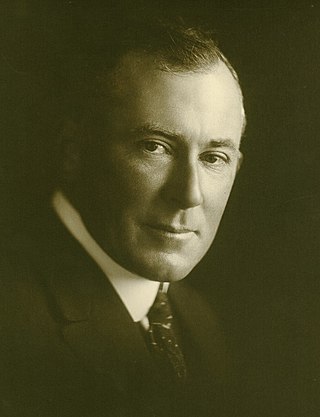
Sir John William Ashton, OBE, ROI was a prolific Australian Impressionist artist and director of the National Art Gallery of New South Wales from 1937 to 1943.
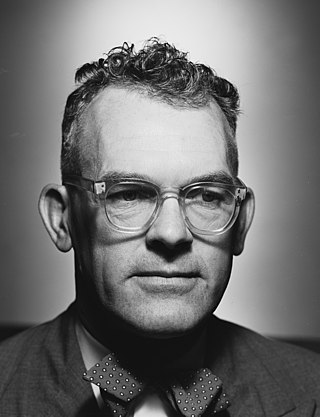
Harold "Hal" Missingham AO was an Australian artist, Director of the Art Gallery of New South Wales from 1945 to 1971, and president of the Australian Watercolour Institute from 1952 to 1955.
Harold Frederick Weaver Hawkins (1893–1977) was an English painter and printmaker working with the techniques of etching, monotypes, linocuts and woodcuts. He specialized in "ambitious, sometimes mural-sized, modernist allegories of morality for an age of atomic warfare and global over-population." He was active from 1923 to 1972.
John William Tristram was an Australian artist who painted primarily in watercolour. He commonly signed his paintings "J. W. Tristram".
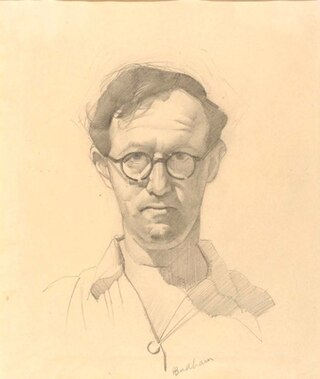
Herbert Edward Badham (1899-1961) was an Australian realist painter and art teacher.
John Charles Goodchild was a painter and art educator in South Australia who mastered the mediums of pen drawing, etching and watercolors. His wife, Doreen Goodchild, was also a significant South Australian artist.

Samuel Calvert was a British draughtsman, printer and artist active in Australia, noted for his wood-engravings, published in contemporary periodicals. He was the third son of the renowned engraver and painter, Edward Calvert. During his period in Australia, Samuel Calvert produced hundreds of engraved illustrations for a variety of publications on a wide range of subjects. Calvert also designed postage stamps for the Victorian government. He was one of the founding members of the Victorian Academy of Art, formed in 1870, and showed watercolours and oil paintings at their subsequent exhibitions. Calvert left a legacy of finely-produced wood engravings depicting landscape, contemporary events and portraits.
Thomas Peerless (1858–1896), commonly known as Tom Peerless, was an Australian artist who painted primarily in watercolour. He signed his paintings "T. Peerless" or, less frequently, with his initials "T. P."
Paul Sidney Goodwin (1875–1944), commonly known as Sidney Goodwin, was an English/Australian artist who painted primarily in watercolour. When he emigrated to Australia he adopted the pseudonym William Young.
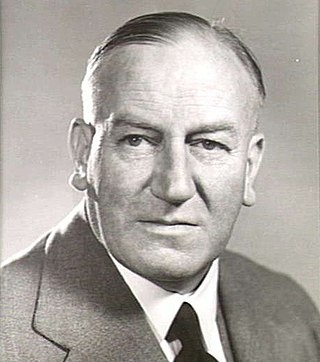
Harold Brocklebank Herbert (1891–1945) was an early 20th century Australian painter and printmaker, an illustrator and cartoonist. A traditionalist, as an art teacher he promoted representational painting, and as a critic was an influential detractor of modernism. He was the first war artist to be appointed for Australia in the Second World War, serving for 6 months with the Australian Infantry Forces in Egypt in 1941 and in the Middle East in 1942.